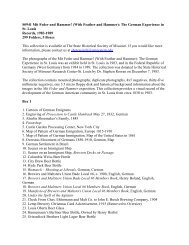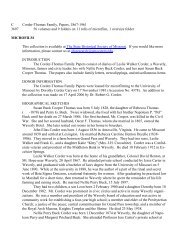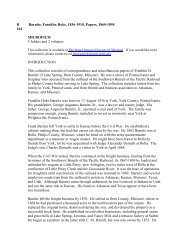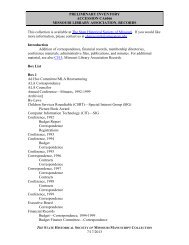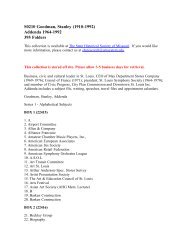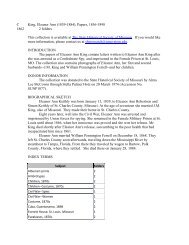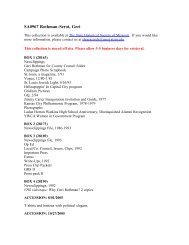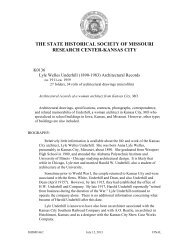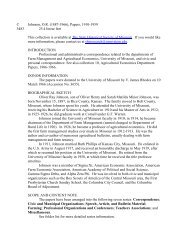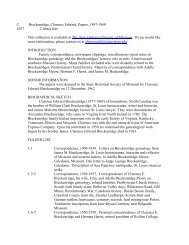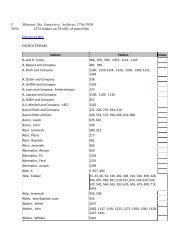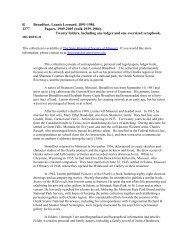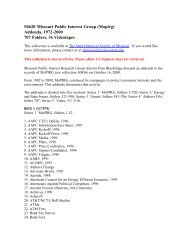Lentz, Theodore F. (1888-1976), Papers, 1926-1983 (S0435)
Lentz, Theodore F. (1888-1976), Papers, 1926-1983 (S0435)
Lentz, Theodore F. (1888-1976), Papers, 1926-1983 (S0435)
Create successful ePaper yourself
Turn your PDF publications into a flip-book with our unique Google optimized e-Paper software.
administrative records for the CRA are incomplete, although a daily journal kept from 1946-<br />
1951 fills in most of the gaps. <strong>Lentz</strong> had a wide correspondence and most is substantive with<br />
discussion of ideas, problems, and methodology. <strong>Lentz</strong>'s developing interest in peace<br />
research is well documented through opinionaires, platform statements, notes, and<br />
correspondence.<br />
Of his three peace research books, Towards A Science of Peace has the most material,<br />
including original ideas, drafts, manuscripts, notes, publication correspondence, book<br />
promotion, book reviews, and foreword and annotations by Julian Huxley. His original idea<br />
for a book in 1948 can be traced through its first publication in 1955. There are a few book<br />
reviews and a topic outline for Towards A Technology of Peace. There are no manuscripts,<br />
notes, or correspondence. Humatriotism was co-authored with twelve other peace researchers.<br />
Correspondence on their portion of the book and biographical sketches of the co- authors are<br />
included.<br />
<strong>Lentz</strong>'s books influenced others and inspired several peace research centers around the world.<br />
Two of these, the Canadian Peace Research Institute and the Peace Centre in England, were<br />
founded by two individuals after reading TASOP. The growth of both centers is documented<br />
in the papers and especially in the correspondence between <strong>Lentz</strong> and Norman Alcock,<br />
Kenneth and Elise Boulding, Hannah and Alan Newcombe, Patrick Deighan, and Paul<br />
Smoker. Articles by these peace researchers were saved because of <strong>Lentz</strong>'s direct influence on<br />
their ideas. The peace research files, along with <strong>Lentz</strong>'s books, reveal how he developed his<br />
ideas. He wrote notes on 3 x 5 cards, scrap paper, and typing paper and these were found<br />
throughout the papers. Many were returned to the donor but a representative group of files<br />
was retained. With folder titles of "Monday, a.m.", "Thots", or "Cogitation", they show how<br />
<strong>Lentz</strong> started with an idea, later wrote about it to a friend, devised a propositionaire, and<br />
eventually included it in an article, book or speech. His notes give the impression of someone<br />
constantly thinking who wrote the process down so as not to forget. Some of the notes are<br />
very personal, in the nature of motivation, perhaps to convince him to continue his work.<br />
<strong>Lentz</strong> had contact with a wide variety of people and organizations. His outreach to the<br />
community included radio talks, education courses, seminars, conferences and speeches.<br />
Many of these are found in the papers. This outreach promoted his ideas, the CRA and the<br />
Peace Research Laboratory and education. <strong>Lentz</strong> was a member, contributor, correspondent<br />
or on the mailing list of numerous pacifist and world government organizations. Sample<br />
brochures and correspondence were saved from 144 organizations to reflect the range of<br />
these groups. A list of organizations is at the beginning of the series.<br />
Oral histories were done with two close friends of <strong>Lentz</strong>, Louise Robison, who lived with<br />
him and Enola, and Joy Guze, a student and lifelong friend. William ckhardt, a colleague and<br />
director of the Peace Research Laboratory after <strong>Lentz</strong>, also was interviewed. Questionnaires<br />
were sent to twelve friends and colleagues around the world for their assessment of <strong>Lentz</strong>'s<br />
influence and contribution to peace research. The responses are included in the papers.<br />
SERIES DESCRIPTION<br />
SERIES 1: CHARACTER RESEARCH TESTS AND MEASUREMENTS, 1928-1947,<br />
FOLDERS 1-52



